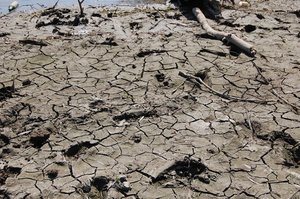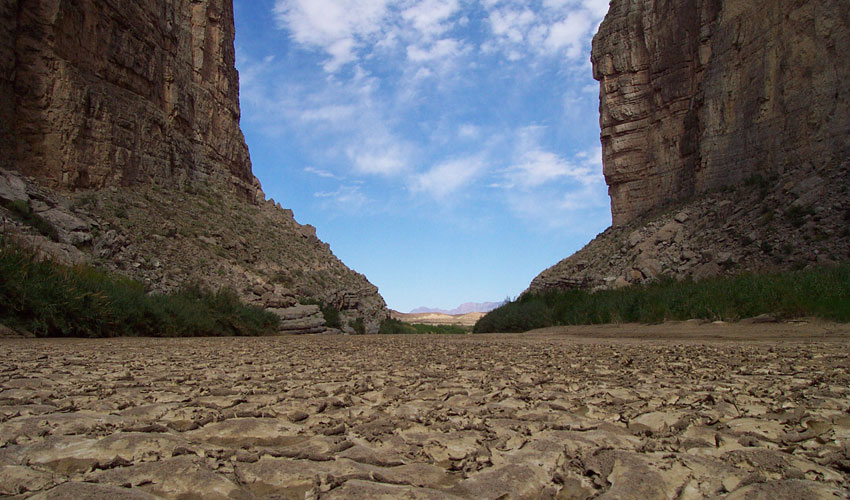Rocky Mountain PBS Announces “Water Week”
Rocky Mountain PBS Announces “Water Week” – A Collaboration of Communities Throughout Colorado to Elevate Conversations on Water
Rocky Mountain PBS (RPBS) will bring Colorado-based organizations and communities together for “Water Week”, an effort to provide resources and information to a broad statewide audience by convening conversations to share the diverse perspectives of Coloradans with respect to water.
“Water Week” features unique, historical and informational programming on RMPBS, along with digital resources, and events in communities across Colorado designed to connect experts, environmentalists and businesses to any of us who see water as an essential part of Colorado’s past and future.
“I think we’re going to see a much longer period of aridity and therefore, incredibly creative thinking that’s going to have to come about,” said Andy Mueller, General Manager for the Colorado River Water Conservation District. “It doesn’t spell the end of civilization in the southwestern United States. What it means though is our civilization’s going to have to transform.”
“One year ago, RMPBS organized a statewide listening tour and engaged local advisory committees to better understand which topics are most important to their communities,” states Amanda Mountain, President & CEO for Rocky Mountain Public Media. “Water repeatedly surfaced as both an historic and contemporary issue, which led us to invest in programming and partnerships to continue these conversations around this critical topic.”
Colorado’s statewide water plan prescribes that conversations about water play a role in shaping our shared future in the state and in the broader West. We asked over 40 water experts to provide feedback to RMPBS about how public media can engage those who are not otherwise actively involved in the topic, as well as how best to expand the number of perspectives represented in critical conversations.
“Water Week” includes RMPBS hosted events across Colorado that are free to local communities:
Come enjoy whiskey and beer tastings, and experience the *NEW* one-hour special, Colorado Experience: Western Water and Power.
Feb 25, 6pm
Colorado Springs: ALMAGRE Venue + Bar
Whiskey Tasting, Colorado Experience: Western Water and Power *full screening*, water information tables.
Partners: Business for Water Stewardship, ALMAGRE Venue + Bar, Sterling Ranch, Ax and the Oak.
Event details and RSVP
Feb 25, 6pm
Gunnison: Western State CO University, University Center Theatre
Colorado Experience: Western Water and Power reception, *full screening* and Q&A.
CO Office of Film (host)
Partners: Business for Water Stewardship; the Colorado Office of Film, Television & Media.
Event details
Feb 26, 6:30pm
Pueblo: Walter's Brewery & Taproom
Beer Tasting / SIZZLE Reel & Colorado Experience: Western Water and Power *promo*, information tables.
Partners: Business for Water Stewardship, Walter's Beer.
Event details and RSVP
Feb 26, 5:30pm
Grand Junction: Eureka! McConnell Science Museum (on CMU Campus)
Whiskey & beer tasting, SIZZLE Reel & Colorado Experience: Western Water and Power *promo*, exhibiting community partners.
Partners: Business for Water Stewardship, Eureka! McConnel Science Museum, Colorado River Water Conservation District, Ute Water, Audubon Rockies.
Event details and RSVP
Feb 26, 6pm
Durango: Fort Lewis College Ballroom
Colorado Experience: Western Water and Power *full screening*, reception with beer, panel discussion.
Partners: Four Corners Water Center, Business for Water Stewardship, Dolores Water Conservancy District; Southwestern Water Conservation District, City of Durango Utilities, US Bureau of Reclamation, Mountain Studies Institute, Water Information Program, H2org.
Event details and RSVP
Feb 26, 5:30pm
Montrose: Ute Indian Museum
Colorado Experience: Western Water and Power *full screening* and Q&A.
Partners: Business for Water Stewardship; the Colorado Office of Film, Television & Media.
Event details
Feb 27, 6pm
Denver: Sterling Ranch Community Center in Littleton
Beer tasting, Colorado Experience: Western Water and Power *full screening*, exhibiting community partners.
Partners: Business for Water Stewardship, Sterling Ranch Colorado, Audubon Rockies, Grist Brewery, For the Love of Colorado.
Event details and RSVP
Feb 28, 5pm
Durango: Powerhouse Science Center
Whiskey & beer tasting, exhibiting community partners (no Colorado Experience screening).
Partners: Business for Water Stewardship, Five Rivers Trout Unlimited, Beer2Clear, Steamworks Brewing Company, Carver Brewing Company, Honey House Distillery, Conservation Colorado, H2org.
Event details and RSVP
All “Water Week” event details for local communities can be found at www.rmpbs.org/events/waterweek/
“Water Week” programming on RMPBS begins on February 27th at 7pm with a new episode of Colorado Experience entitled “Western Water & Power”. This program visits the history of Western settlers who dreamed of deserts in bloom, where they chased the mirage of more water than the arid lands could provide. “Whiskey is for drinking and water is for fighting,” describes the urgent struggle every generation of Coloradans faces to control this fleeting but precious resource -- creating hydrodynamic history through structures that can propel water to run uphill toward money and power.
Immediately following at 8pm, Colorado Experience: “Living West – Water” will explore what happened to the Ancestral Pueblo people of Mesa Verde and Goodman Point. After settling in southwest Colorado for over 700 years, the ancestral Pueblo people suddenly left their cliff dwellings and spring-side kivas, leaving behind a variety of archaeological treasures. In this episode, historians and archaeologists discuss the possibility that this drastic move was caused by a devasting drought in the southwest region. Discover the similarities in historic conditions – and what the disappearance of water might mean for the state of Colorado today.
Continuing at 8:30 pm, Confluence tells the story of The Colorado River, which runs through the Western Slope, shaping both the landscape of the American Southwest and the people living near its waters. Confluence follows an up-and-coming indie folk band as they traverse this endangered river system, documenting its places and people through original music.
“Water Week” concludes its programming with “Arkansas River: From Leadville to Lamar” airing at 9:30pm. This program explores the economic and social importance of the river basin including its recreational, municipal, and agricultural value. By the year 2050, the population of Colorado is expected to double, but future growth and economic development hinges on a dependable water supply. In response, the state has developed a plan that will meet the needs of all water users. On RMPBS, come discover why the Arkansas River basin is an important part of that new water plan.
RMPBS wishes to thank all of the local community and statewide partners in supporting our mission of strengthening our civic fabric and convening important conversations that impact our state. Locally RMPBS has received support from the Bureau of Reclamation, Mountain Studies Institute, City of Durango Utilities, Southwest Water Conservation District, Dolores Water Conservancy District, Water Information Program, Powerhouse Science Center, Carver Brewing Company, Steamworks Brewing Company, Five Rivers Trout Unlimited, Beer2Clear, Honeyville’s Honey House Distillery, and the Four Corners Water Center at Fort Lewis College.
On Thursday February 27th RMPBS will also be hosting Carver’s Green Drinks from 5:00-6:45PM to talk about the events of Water Week.
For more information regarding “Water Week,” to RSVP to events, access resources, and learn how to get involved, visit the Rocky Mountain Public Media website at: rmpbs.org/events/waterweek/. The page includes a curated list of resources, and all Coloradans are invited to participate in a statewide survey on attitudes and knowledge are related to water.
Broadcast Schedule:
7pm - *NEW* Colorado Experience: Western Water---And Power
Ever since Western settlers dreamed of deserts in bloom, men have chased the mirage of more water than these arid lands can provide.
8pm - Colorado Experience: Living West - Water
What happened to the Puebloans of Mesa Verde and Crow Canyon? Historians discuss the possibility that this move might have been due to a drought in the Southwest region.
8:30pm - Confluence
The Colorado River shapes both the landscape of the American Southwest and the people living near its waters.
9:30pm - Arkansas River: From Leadville to Lamar
Arkansas River from Leadville to Lamar explores the economic and social importance of the river basin including its recreational, municipal, and agricultural value.
About Rocky Mountain Public Media
Rocky Mountain Public Media is Colorado’s largest statewide, member-supported, multimedia organization and the parent company of Rocky Mountain PBS, KUVO Jazz and THE DROP. Rocky Mountain Public Media has more than 90,000 members representing every county in Colorado and reaches 98% of the state’s citizens through television, radio and digital platforms. A non-commercial media organization by and for the people of Colorado, we create high quality local and multimedia content through Regional Innovation Centers in Denver, Colorado Springs, Durango, Grand Junction and Pueblo. Our enriching journalism, educational and cultural programming connects and engages citizens for lifelong impact. RMPBS, started in Denver in 1956 as Colorado's first public television station, is now a statewide television network, with stations in Denver (KRMA), Pueblo/Colorado Springs (KTSC), Steamboat Springs (KRMZ), Grand Junction (KRMJ) and Durango (KRMU). Visit us at www.rmpbs.org.
Contact: Debbie Higgs (970) 235- 8707 // debbiehiggs@rmpbs.org
Ballantine Media Center, 1000 Rim Drive
Durango, CO 81301
New, Colorado Water Plan Interactive Map
The water Coloradans use to drink, irrigate crops, recreate, and sustain our communities is water that we share with our rivers, streams, and lakes. But climate change and population growth are straining water supplies across our state. Colorado’s Water Plan provides a blueprint to ensure we can meet future demands while also keeping our rivers healthy and flowing. The Plan includes local projects that can help make our communities more sustainable, ensure safe drinking water for all Coloradans, help our economy thrive, and protect water resources and wild ecosystems for future generations.
In addition to the map, check out these short videos talking about the various water projects happening around the state and how the Colorado Water Plan made that possible.
CTU Supports Proposition DD: A letter from the Executive Director
With Election Day right around the corner, I’m writing on behalf of Colorado TU to recommend you vote YES on Proposition DD and help invest in the future of Colorado’s rivers and watersheds.
Proposition DD would add a 10% tax on casinos’ sports betting, generating up to $29 million in annual proceeds to invest in Colorado’s water future. Only the casinos will pay, but all of Colorado stands to benefit.
The last time a major statewide water funding measure was on the ballot – the $2 Billion Referendum A in 2003 – Colorado TU was a vocal opponent. So what has changed? This time, there is a plan for how to use the funds – Colorado’s Water Plan – and it places much-needed emphasis not only on meeting water needs for our growing population but also on preserving the healthy rivers and productive agricultural lands that are so much a part of what makes Colorado a great place to live and work.
Colorado is in urgent need of more funding to implement its water plan because its population is expected to double by 2060, and current water supplies cannot keep up with demand in the future. Investment in our water system must be a priority to meet our water needs while preserving Colorado water values for healthy rivers and thriving farms. From projects for river and watershed health, to modernizing irrigation systems to improve efficiency, to conducting balanced multi-purpose projects, funding for Colorado’s Water Plan is critical to preserve our Colorado way of life.
Just as Great Outdoors Colorado (GOCO) has done for our open space and park lands, Proposition DD promises to spur much-needed investments and partnerships to benefit our waters. It is an important down-payment on Colorado’s water future.
Please join us in supporting Proposition DD – and don't forget to tell your friends and family to do the same!
Sincerely,
David Nickum, Colorado TU Executive Director
In the News
https://www.postindependent.com/opinion/letter-support-colorado-proposition-dd/
Trout Unlimited: Colorado has a water plan; now let’s fully fund it: https://www.tu.org/blog/colorado-has-a-water-plan-now-lets-fully-fund-it/
Doom and Gloom, but what can I do?
Drought is plaguing most of Colorado and pretty much everywhere in the southwest. Every summer, it feels like we are saying the same thing and warning everyone about not enough snowpack melt, low flows and warming waters. Whether you are a native, transplant, or visitor to this great state - we can all do something to make a difference in conserving our scarce water sources.
Most of these ideas are easy to do, while some take practice. Even just adopting one strategy to conserve water, can make a difference. Feel free to leave a comment about your ideas as well!
1. When brushing your teeth or shaving try not to the let faucet run. Need water? Fill up the sink instead to rinse your razor and turn off the faucet between brushing.
2. Most dishwashers do not require any pre-rinsing, especially if they are relatively new. Instead, scrape off any food (preferably into compost) then run the cycle when the dishwasher is full. Some dishwashers even have a "water saver" cycle you can try.
3. Are you still rinsing your produce under the faucet? Try filling a bowl or tub to rinse them in and reuse the water on your houseplants or garden outside.
4. Try using a broom to clean off sidewalks, driveways, patios, or decks instead of the hose.
5. Tired of mowing the lawn? Check out xeriscaping alternatives to replace or reduce the amount of grass in your yard. If you do need to mow, keep the trim length minimal to reduce evaporation and increase soil moisture retention which will reduce your need to water it. Having longer grass will help it grow a stronger root system and increase it's drought and pest tolerance.
6. Are you still trout fishing when the water is climbing above 65 degrees? Giving fish a break can increase their chances of surviving during this stressful time. Check out our handy water temperature thermometer for trout.
There are plenty of ways to conserve water in the west and with the rise of energy and resource saving standards in our appliances and home systems, it's becoming easier and easier to use less water without even thinking about it. If you are interested in learning more about the innovative ideas out there regarding water conservation, check out the links below. Colorado's rivers and the trout that live in them will thank you!
Resources & Other Water Saving Tips
Water Conservation in the Home
What is greywater? How is it used?
Greywater Opt-in Colorado Legislation
Water Conservation across Colorado
Xeriscaping in Colorado: Budgeting, Design, How to
Free Xeriscaping Plans & Plant Suggestions
Celebrating the Colorado River
Celebrate with us by sharing the graphic above.
The Colorado River is said to be one of the most important water sources in the west, as it contributes to 7 different states' watersheds. July 25 marks the special day that we all use to celebrate this river. As part of the celebration, storytellers throughout the basin share how important the river is to their community below:
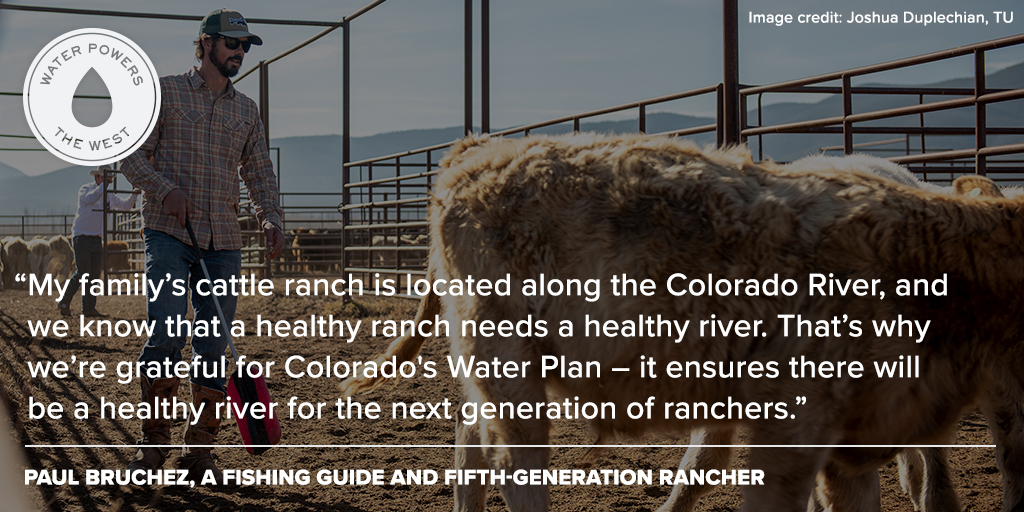
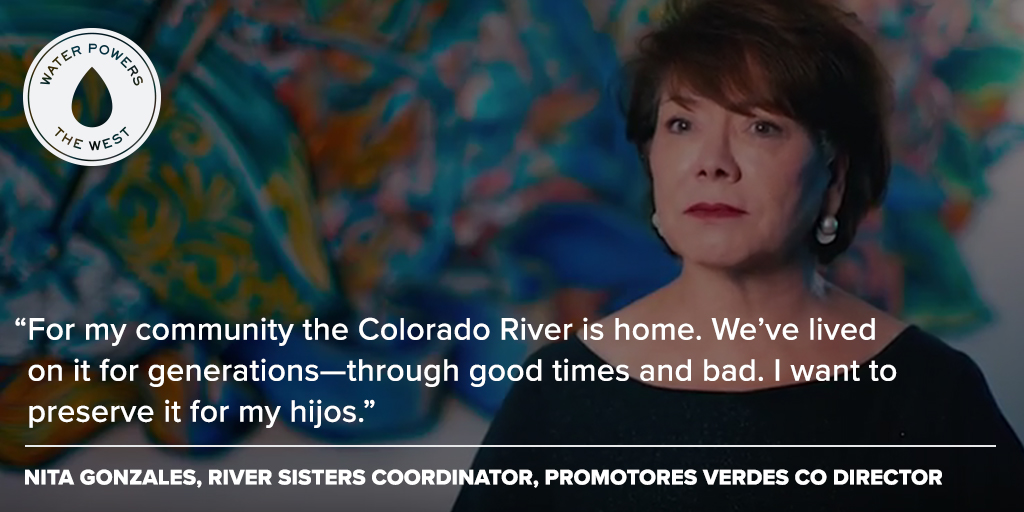

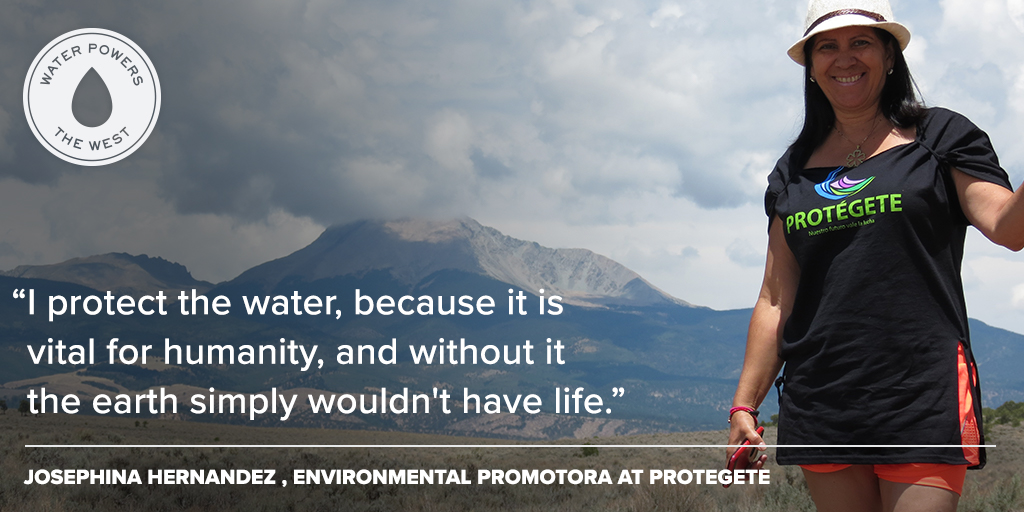

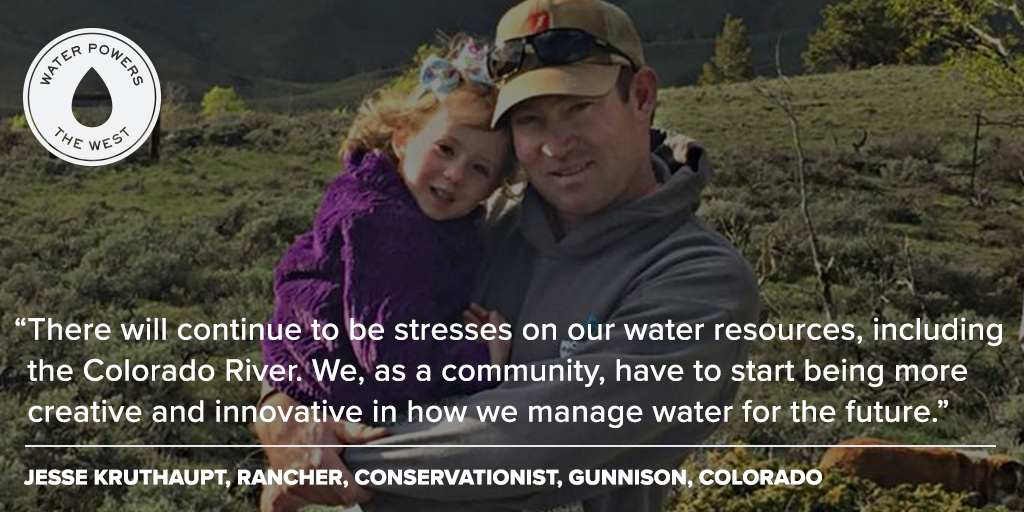

What's in a drought? That which we call a drought.
Rafters enjoy floating down the Colorado River in the Grand Canyon. Boating down the Colorado River below Havasu Creek in Grand Canyon National Park. NPS photo by Mark Lellouch.
A report published by the Colorado River Research Group takes a look at the word "drought" and why it might be time to retire its usage based on the data seen from the Colorado River Basin.
“Drought: a period of dryness especially when prolonged; specifically : one that causes extensive damage to crops or prevents their successful growth”
Water is a hot commodity for ranchers across Colorado.
A sign advertising a water sale sits on a farm outside Del Norte, Colorado. Luke Runyon / HARVEST PUBLIC MEDIA
According to that definition, a drought refers to a period of time which would mean there is a beginning and a foreseeable end. What we are noticing in Colorado is a drought that seems to have no end. That's why scientists from Arizona, Utah, California, Colorado, and Michigan are starting to label the changes we have seen in the Colorado River Basin as aridification. It's true that the word does not share the same one-syllable punch that drought delivers, but the research groups says that it better defines what is happening to the area.
“aridification: the gradual change of a region from a wetter to a drier climate, often measured as the reduction of average soil moisture content”
A riverbed dried up along the Rio Grande.
What this study suggests is that the years upon years of weather patterns we have seen in Colorado are pointing to a larger trend that is simply more than just a temporary drought or warming. If you are interested in learning more, you can read the full report with the link below. As always, what do you think? Is it time to start calling a spade a spade?
Other topics addressed in the report include:
- Measuring the likelihood of future megadroughts in terms of low soil moisture
- What studies say about the "dust on snow" phenomenon
- What are two possible new normals based on climate models, trends, and Colorado population demand and growth
Read the Full Report here:
When is Drought Not a Drought? Drought, Aridification, and the "New Normal" (March 2018)
P.S. Did you catch the Shakespeare reference?










